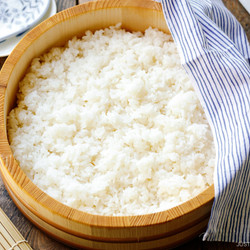One thick sushi roll (Futomaki) requires 1⅔ cups (250 g) of sushi rice. One medium sushi roll (Chumaki) like Vegetarian Sushi Roll requires 1 cup (150 g) of sushi rice. One thin sushi roll (Hosomaki) requires ½ cup (80 g) of sushi rice. One inside-out sushi roll (Uramaki) like California Roll requires ¾ cup (110 g) sushi rice. One nigiri sushi requires 20 g of sushi rice.
How to Measure: Overfill a ¾ cup measure or a plastic rice cooker cup with uncooked short-grain white rice and level it off. Put the rice in a large bowl. Repeat until you have the amount needed. Tip: You must use Japanese short-grain white rice or your sushi will fall apart. Please note that 2¼ cups (450 g, 3 rice cooker cups) of uncooked Japanese short-grain rice yield 6⅔ cups (990 g) of cooked rice.
Gather all the ingredients.
Quick Rinse: Add just enough water to submerge all the rice. Then, discard the water immediately. Tip: Rice absorbs water very quickly when you start rinsing, so this step helps remove impurities from the rice and prevent it from absorbing the first few rounds of milky water.
Wash: Next, use your fingers to gently agitate the wet rice grains in a circular motion for 10-15 seconds. Using very little water allows the grains to rub against each other. It also reduces the absorption of impurities from the milky water.
Rinse: Add water and immediately discard the cloudy water. Repeat Wash and Rinse (steps 2 and 3) two more times.
Drain: When the water is almost clear, drain the rice very well. Tip: Use a fine-mesh sieve to drain and shake off any excess water.
Put the well-drained rice in the inner pot of the rice cooker and add the measured water. If your rice cooker has a Sushi Rice mode, add water up to that line. If not, add water to just under the 3-rice-cooker-cup line for White Rice (for 2¼ US cups of uncooked rice). Tip: For sushi rice, the ratio of short-grain white rice to water is only 1 to 1 by volume—less liquid than for regular steamed rice—to account for the seasoned sushi vinegar that we add to the cooked rice.
Check the kombu to see if there are any dirt particles. If needed, gently wipe it off with a damp cloth (it‘s a traditional method but these days kombu is pretty clean). Do not wipe off the white powdery substance, which contributes to the umami flavor. NEVER wash the kombu! Now, place the kombu on top of the rice in the rice cooker bowl.
Soak and Cook: Let the rice soak in the water for 20–30 minutes. Then, start cooking. If you don‘t have a rice cooker, cook the rice in a pot over the stove, Instant Pot, or donabe with the amount of water I specified in this recipe.
If you are not using a store-bought bottle of sushi vinegar (seasoned rice vinegar), follow this step. Combine the rice vinegar, sugar, and salt in a small saucepan.
Bring it to almost simmer over medium-high heat. Whisk until the sugar is completely dissolved. You can also put the ingredients in a microwave-safe bowl and microwave for 1 minute, or until the sugar is dissolved. Set aside to let it cool.
If using a wooden sushi oke (also called hangiri), moisten it by running water over it, drain well, and dry it with a clean towel. You can also use a large salad bowl or baking sheet lined with parchment paper. Tip: This wooden tub helps absorb excess moisture while a ceramic bowl can't.
When the rice is cooked, discard the used kombu (or repurpose it to make simmered kombu).
Transfer the cooked rice into the sushi oke. Spread out the rice evenly so it will cool faster.
While it’s hot, pour the sushi vinegar over the rice.
With a rice paddle, gently “slice” the rice at a 45-degree angle to incorporate the sushi vinegar mixture and separate the chunks of rice. Do not stir or mix the rice because the grains may break and the rice will become mushy. While using this slicing motion, vigorously fan the rice with a paddle fan or another type of fan. Fanning takes away the excess moisture and makes the rice shine.
Then, gently flip the rice in between slices.
Repeat this process until the rice is cooled to the temperature of human skin. Your Sushi Rice is now ready to use in your favorite sushi recipes.
Keep the sushi rice covered with a damp towel (or paper towel) for a few hours at room temperature. To keep it for a longer time, see below.
Rice gets hard and dry in the refrigerator. My recommendation is to put the sushi rice in an airtight container and store it in the freezer for up to a month. You can defrost it overnight in the fridge, and then microwave to room temperature (not hot). If you really want to refrigerate it, cover the container with a thick kitchen towel, so the rice will stay cool but not become cold.
